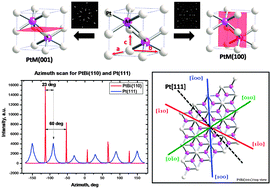Fabrication and surface characterization of single crystal PtBi and PtPb (100) and (001) surfaces
Abstract
High quality single crystal

* Corresponding authors
a
Department of Chemistry and Chemical Biology, BakerLaboratory, Ithaca, USA
E-mail:
hda1@cornell.edu
Fax: +1-607-255-9864
Tel: +1-607-255-4720
b Energy Materials Center at Cornell (EMC2), Cornell University, Ithaca
c G-line Station, Cornell High Energy Synchrotron Source (CHESS), 200L Wilson Laboratory, Ithaca
d National Institute for Materials Science (NIMS), Sengen 1-2-1, Tsukuba, Ibaraki 305-0047, Japan
High quality single crystal

 Please wait while we load your content...
Something went wrong. Try again?
Please wait while we load your content...
Something went wrong. Try again?
Y. Liu, H. Abe, H. M. Edvenson, T. Ghosh, F. J. DiSalvo and H. D. Abruña, Phys. Chem. Chem. Phys., 2010, 12, 12978 DOI: 10.1039/C0CP00321B
To request permission to reproduce material from this article, please go to the Copyright Clearance Center request page.
If you are an author contributing to an RSC publication, you do not need to request permission provided correct acknowledgement is given.
If you are the author of this article, you do not need to request permission to reproduce figures and diagrams provided correct acknowledgement is given. If you want to reproduce the whole article in a third-party publication (excluding your thesis/dissertation for which permission is not required) please go to the Copyright Clearance Center request page.
Read more about how to correctly acknowledge RSC content.
 Fetching data from CrossRef.
Fetching data from CrossRef.
This may take some time to load.
Loading related content
